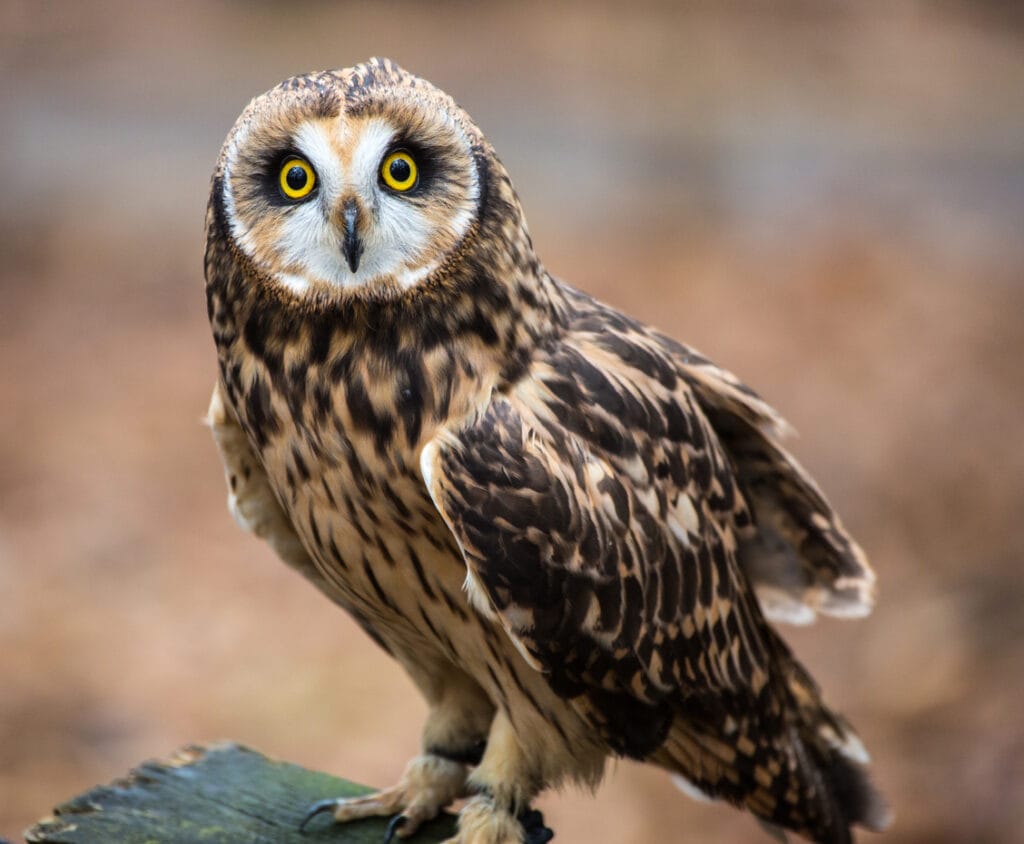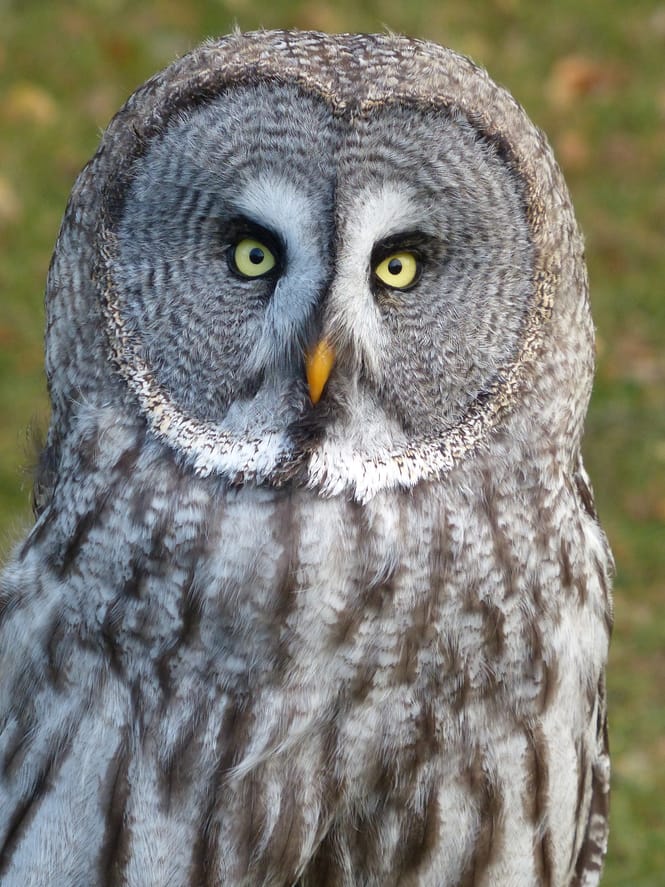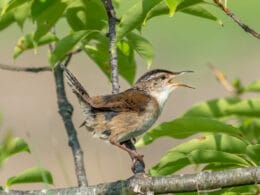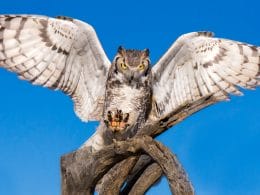The owl is an almost mythical creature, steeped in culture and mystery. Perhaps it is because they are largely nocturnal and so, rarely seen or maybe because they are such unusual animals with unreal looks and spooky sounds. Regardless of the the reasons, we love them. In the United States there are 23 species of owl seen according to the ABA. In this post we look at all of them.
Burrowing Owl (Athene cunicularia)

The Burrowing Owl is unusual in lots of ways. Firstly, it is active in the day. Next, it spends its time in small groups. Lastly, it live in burrows made by other animals, in the ground. It can be found in the western side of the United States and into Mexico. There are sightings across the continent, however, and into the Caribbean.
Great Horned Owl (Bubo virginianus)

The Great Horned Owl is not only one of the most common owls reported in the U.S., but it is also the most fearsome. A large bird with a red and gray morph, it is capable of taking a range of large prey and is a ruthless killer. It can be seen from the top of South America, through the U.S. and into Canada and Alaska.
Barred Owl (Strix varia)

The Barred Owl is quite active in the day, although its cryptic gray and brown coloring makes it difficult to spot. It can be found in forests, usually near water. Consequently, it inhabits the eastern and northwestern areas of the United States, as well as parts of Canada.
Eastern Screech-Owl (Megascops asio)

The Eastern Screech-Owl is a small bird with a disproportionately large head and it has a gray and red morph. Hunting at night for small mammals and birds, it has a whinny like call, hence the name. This owl is widespread across the eastern and central parts of America.
Short-eared Owl (Asio flammeus)

This is an unusual looking owl that is often seen at dawn and dusk. The head almost looks too small for the eyes. It is our first international owl with populations through Russia, Asia, Europe as well as throughout the United States. It is less reported in southern desert areas.
Elf Owl (Micrathene whitneyi)

The Elf Owl is incredible in that it is only the size of a sparrow! Its coloring is red, gray and white and it is nocturnal. It inhabits areas in the south west that border the desert. All of which makes it very difficult to find.
Western Screech-Owl (Megascops kennicottii)

Unlike the Eastern Screech-Owl, the Western only has a gray morph. it is small with ear tufts that may or may not be visible. Its range is restricted to the western seaboard, all the way from Mexico up to Alaska.
Barn Owl (Tyto alba)

The Barn Owl is the only member of the Tyto owl family seen in the U.S. It is a stunning bird, not usually seen in broad daylight but often at dawn and dusk. Its pale front is complemented by a rusty brown on the back. It is probably the most widespread owl in the world found everywhere except for the polar caps.
Northern Saw-whet Owl (Aegolius acadicus)

This tiny owl can be found in forests and mountains from Mexico, through America to Canada. It is cryptically colored brown and cream and with its size, is very difficult to spot. It is so named for its call sounding like a saw being sharpened on a whet stone.
Northern Pygmy-Owl (Glaucidium gnoma)

The Northern Pygmy-Owl is a rather rare bird, found on the western side of the continent, from Canada down to Mexico. It is an attractive dark brown overall with a paler, streaky front.
Whiskered Screech-Owl (Megascops trichopsis)

This is our last Screech-Owl and it is resident in Mexico, inhabiting woodlands and canyons. On occasion, it will stray into southern Arizona. It has an attractive plumage with black, white and gray patterning.
Ferruginous Pygmy-Owl (Glaucidium brasilianu)

The Ferruginous Pygmy-Owl is so named for its beautiful, rusty plumage. It is a small owl and often seen in the daytime. Resident in the tropical lowlands of Mexico, it occasionally is reported in southern Texas and Arizona.
Flammulated Owl (Psiloscops flammeolus)

This is a very odd looking owl, with dark eyes even at night. It has a fine patterning with grays and some red. It is a migratory owl, moving between southern Canada and Mexico. It can be seen sporadically throughout western America.
Boreal Owl (Aegolius funereus)

The Boreal Owl is another large-headed owl that is rarely seen during the day. Its plumage is a mix of grays and the black ring around the face is diagnostic. It is a northern bird, inhabiting boreal forests. It can be found throughout northern states and Canada and Alaska.
Snowy Owl (Bubo scandiacus)

Possibly the most iconic owl, made famous by the Harry Potter films, the Snowy Owl really is stunning. Its plumage varies from pure white to a dark, thick barring. It can be seen during the day and in open areas, making it more likely to be seen than other owls. Its range is most concentrated in the south east of the U.S. and then through the country moving north. There are sightings across the Northern Hemisphere.
Stygian Owl (Asio stygius)

The Stygian Owl is a large and slim owl with dark plumage and long ears. It is a very rare bird of Central America with less than 10 sightings in Texas on eBird.
Mottled Owl (Strix virgata)

The Mottled Owl is a common owl of Central American forests, gardens and towns. Its round face and eyes are framed by large pale brows. It is a very rare visitor to southern Texas.
Oriental Scops-Owl (Otus sunia)

This is a very attractive rufous owl with bright yellow eyes. It can also be found in a gray morph. It is resident in south-east Asian countries and an extremely rare vagrant to the USA.
Long-eared Owl (Asio otus)

The Long-eared Owl is a long, slim owl with, surprisingly, relatively long ears. It has deep set eyes in a plumage with varying colors from cream to brown to rufous. It is sporadically found across continental America as well as other countries across the Northern Hemisphere.
Northern Hawk Owl (Surnia ulula)

The Northern Hawk-Owl is an unusual species with a very long tail that is often seen splayed. It is dark overall and barred on the front. It inhabits northern forests into Canada and Alaska.
Spotted Owl (Strix occidentalis)

The Spotted Owl is another diminutive bird with dark brown coloring and pale large spots. it is seen across desert areas in Arizona, New Mexico, Colorado and Utah. The other main population is from Los Angeles through to Vancouver.
Northern Boobook (Ninox japonica)

The Northern Boobook is a slim brown owl, with large golden eyes. It is a forest resident of south-east Asia and is a very rare vagrant to the U.S.
Great Grey Owl (Strix nebulosa)

And we finish with the spectacular Great Grey Owl. It is a relatively rare bird but can be seen at dawn and dusk while it hunts. It inhabits far northern areas of the U.S. and into Canada and Alaska.
Conclusion
So there we are, 23 species of owl reported in the U.S. There are 2 families of owls – the Strigidae and Tytonidae. The Barn Owl is the only member of the latter and all other owls fall into the former. Owls are more common than we think, as we don’t see them very much, which is a shame as they are such interesting and exciting birds.
We hope you enjoyed our post on owls in the United States.
FAQ
The Great Horned Owl is thought to be the most common in the United States although these mysterious birds are a bit tricky to count!
Smaller owls may be predated on by larger owls, snakes, hawks and 4-legged mammals. Large owls like the Great Horned Owl are apex predators but still may hunted by eagles.
Yes, they have exceptional hearing and sight, both of which are needed to hunt in the night hours.










